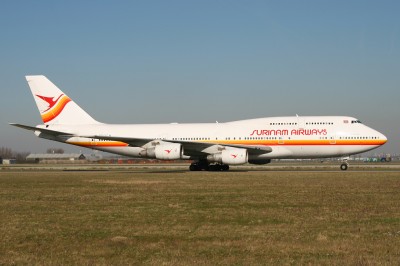
Surinam Airways Boeing 747-300 (PZ-TCM)
Surinam Airways was founded in 1955 and is the national airline of Surname. It is fully owned by the Suriname’s government and operates to only nine destinations. The airline currently only has a fleet of three aircraft, one Airbus A340-300 and two Boeing 737-300’s. In November 2009, Surinam Airways purchased the Airbus to replace the Boeing 747-300 in the photo.
Can you notice the slight changes of livery on the newer Airbus 340 versus the older Boeing 747-300.
Image: PlaneSpotting
connect | web | twitter | facebook |
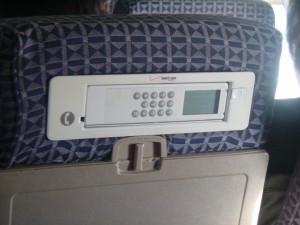
Remember these? They were aboard a lot of flights, barely used and cause few disruptions. Would personal cell phones be worse?
People on cell phones can be very annoying. However our society runs on cell phones. Using cell phones to talk on airplanes in the United States is banned, but not in all places of the world.
Mary Kirby, on her blog RunwayGirl, took a look at cellphone usage on airlines that already allow it.
AeroMobile, who currently provides cell phone service on 60 of Emirates’ aircraft, had over 11,000 voice calls in February 2010. Yes, with the vast number of passengers who flew on Emirates during that time, it is not an overwhelming percentage, but 11,000 calls still shows there is a demand for airborne phone conversations.
Kirby’s blog has lot of interesting graphs showing how cell phone calls from flights are greatly increasing. There has been talk of cell phone calls being allowed on US flights in the near future.
My personal opinion? Ugh.
First off all, I am not a fan of talking on the phone. I prefer email, texting and using Twitter vs talking on the phone. The fact that I am not reachable by phone, is ok by me. However, the airline industry doesn’t run based on just what I want (would be cool if they did). I know it would be a revenue builder for airlines, but would it be worth it?
Some ask, “How is it any different from two people talking to each other, who are sitting next to you?” There’s a big difference. A lot of people on cell phones are louder and less aware of their environment. I have been on buses, trains, in just general public and heard people talk about things on a cell phone they would never talk about that loudly in person (once I even heard a person even gave their full credit card number, date of birth and other personal information loudly over their cellphone). How many times do I need to hear, “Can you hear me now?”
Currently the FAA does not allow cell phones to be turned on during flight in the US, from fear the signals could interfere with the airplane’s equipment. However, many flights globally have shown that cell phones cause no threat to airlines (Myth Busters also showed they caused no harm a while back as well).
My initial reaction has been to keep cell phones banned, but am I off base? I mean, cell phones have been active in flights since 2007 around the world and there hasn’t been any backlash or huge fights caused like some had predicted. Of course calls are limited since not many airlines offer it. They are expensive and only a few lines are offered on each flight, but those can all change. Many airlines are already moving towards offering internet on flights, should cell phones be next?
connect | web | twitter | facebook |
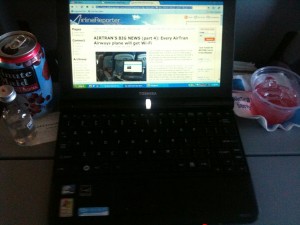
Taken right now. Glad I got a mini-laptop and yes that is an "adult" drink, but I am sitting up front & it's free! Reading a sweet blog.
Currently flying at 30,000 feet on an AirTran flight from Atlanta to Milwaukee and back home to Seattle. I love flying and I love the internet. Having the internet while flying is awesome.
I have spent the last two days in Atlanta at AirTran’s Atlanta Corporate Center, where flight attendants are trained. Sorry I haven’t had any new blogs (am going to work on a few while flying), but I ended up with a lot less free time than I expected.
However the things I have experienced, and the people I met were amazing. I have always respected the job flight attendants do, but my respect has gone to a whole new level.
I plan to be working on a few blogs about the experience over the weekend and post them next week. Thanks for everyone who was following me on Twitter and a thanks to AirTran for hosting me and being very welcoming.
Ok we are starting our decent into MKE, so I better post the blog!
connect | web | twitter | facebook |
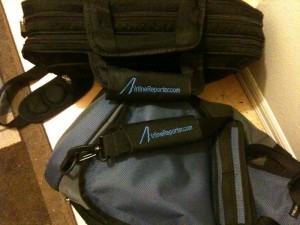
My custom luggage handles...yes I am a nerd.
I am sitting at Seattle-Tacoma International Airport once again (and enjoying their free wi-fi). I am off to Atlanta to do some cool things with AirTran for the next few days. Just in time, I have been getting that desire to get airborne again!
I am going to learn some aspects of being a a flight attendant at AirTran’s training facility, which will kick off a new series on my blog where I explore different airline related jobs. You can expect some blogs on my adventure in the near future and until then follow my Twitter.
Because of scheduling I am actually going to be flying a red-eye on US Airways to Charlotte, then down to Atlanta. It will be a long night, but who needs sleep? US Airways just announced they have started providing GoGo Inflight WiFi on a few of their Airbus A321’s. Just so happens I am flying a A321 to Charlotte. Part of me hopes it doesn’t have WiFi so I can get some sleep.
connect | web | twitter | facebook |
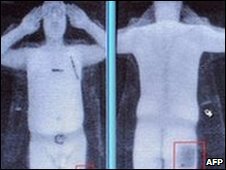
Image from a body scan
From the beginning I have been against airport body scanners. Not only because of the privacy aspect, but they just don’t work effectively. I have been watching closely the development of the body scanners, which are starting to be used around the world, and problems are already popping up.
Probably the biggest issue is that the body scanners can easily be avoided. Stephen Frischling recently looked how even the very best security is no good, if someone wanting to do harm can just circumvent it.
Kathleen Petrowsky, the Transportation Security Administration’s (TSA) Director at Chicago O’Hare Airport, first stated it would be mandatory for all passengers to be scanned with the body scanners. However, after making that statement, Frishling received a reply from the TSA’s blog team stating, “Imaging technology is optional. No plans to make it mandatory’¦ Anything else you read is incorrect.” Frischling confirmed this with the TSA’s Public Affairs unit that the scanners would be optional. Passengers who do not want to be scanned would be able to have a pat down instead.
Hmm. We are told that pat downs are not affective enough at stopping terrorists; so we need the body scanners, yet they are not required? What would stop someone who wanted to do harm to request a pat down? Not to get too graphic but there are a lot of places someone could hide something they don’t want found. At about $150,000.00 a pop is this really a good investment?
Does this mean I am advocating the body scanners be required? No way! Putting the fact you can avoid them aside, there is still the issue of privacy. JetBlue’s BlueTales blog recently reported about a security agent who made a sexually charged remark about a passenger who accidentally walked through a body scanner at London Heathrow Airport. He stated, “love those gigantic ****” (click here for the actual wording) when the 29 year old female passenger walked through.
The machines are designed well and they do a good job. The weak part are the people. Don’t get me wrong, the majority of TSA workers are great workers and do a wonderful job. But you only need a few people to screw up a whole process. Yes, in America the TSA will be in a remote location reviewing the scanner images so passengers won’t have to hear if they make any inappropriate comments.
I really think it has to do more with security theater than anything else. It costs a lot of money, we are already seeing the privacy issues and it can be avoided all together, so what is the point? If passengers don’t feel safe, they won’t fly. These machines make most passengers feel safe even though in reality they aren’t any safer. Is it more important to spend money on safety you can see or safety that works?
Image: BBC
connect | web | twitter | facebook |




